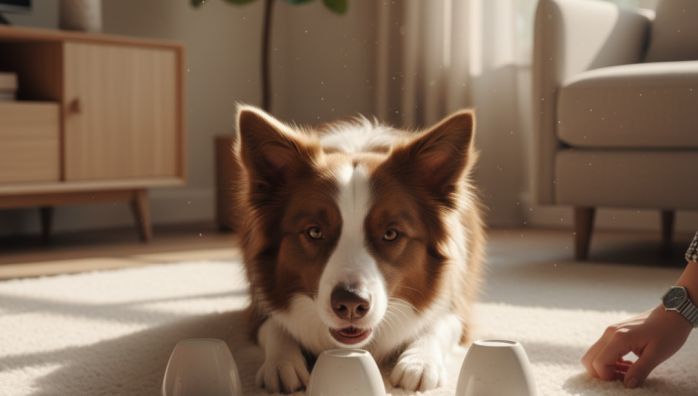Indoor Games for High-Energy Apartment Dogs
by admin in Pet Care Basics 12 - Last Update November 18, 2025

When I first brought my energetic Aussie mix, Leo, home to my 700-square-foot apartment, I had a near-constant knot of anxiety in my stomach. Was I being cruel? Could a dog with this much get-up-and-go truly be happy without a sprawling backyard? The guilt was real, especially on rainy days when our long walks were cut short and he’d resort to frantic zoomies around my coffee table. It took time, but I eventually learned a secret weapon that changed everything: indoor games that targeted his brain, not just his body.
Why mental exercise is a non-negotiable
I used to think that a tired dog was one who had run for miles. And while physical exercise is crucial, I discovered that 15 minutes of focused brain work could tire Leo out more effectively than an hour of frantic, leash-pulling walks. Mental stimulation forces them to problem-solve, concentrate, and use their natural instincts. For intelligent, high-energy breeds, this isn\'t just a bonus; it\'s a fundamental need. Ignoring it is often the root cause of destructive behaviors like chewing and barking. I learned that I wasn\'t just playing games; I was fulfilling a deep-seated canine need.
My go-to games for saving sanity (and furniture)
Over the years, we\'ve developed a solid rotation of indoor activities. These are the ones that have stood the test of time and work wonders for channeling that brilliant, boundless energy into something positive.
The \'find it\' game
This is, without a doubt, our number one. It\'s simple, free, and taps directly into a dog\'s most powerful tool: their nose. I started by having Leo sit and stay while he watched me place a high-value treat under a blanket a few feet away. Then I’d release him with the cue \"Find it!\". He caught on so fast. Now, I have him stay in another room while I hide treats or his favorite toy all over the apartment—under rugs, on low shelves, behind pillows. Watching him methodically work the room, nose twitching, is incredibly rewarding. It’s a calm, focused activity that leaves him happily exhausted.
Puzzle toys and snuffle mats
I\'ve invested in a small collection of puzzle toys, and they are worth their weight in gold. We have treat-dispensing balls and more complex slider puzzles. The key, I\'ve found, is rotation. If I give him the same one every day, he solves it in seconds. By rotating them, I keep the challenge fresh. A snuffle mat—a fabric mat with fleece strips for hiding kibble—is perfect for meal times. It slows down his eating and turns breakfast into a fun foraging activity.
DIY agility and obedience training
You don\'t need professional equipment to work on basic agility and focus. I use pillows and blankets to create a mini obstacle course for him to navigate. We practice weaving through chair legs, pausing on a folded towel (our makeshift \"pause box\"), and crawling under a sheet draped over two chairs. Interspersing these with 5-minute sessions of refreshing basic commands like \'stay,\' \'place,\' and \'leave it\' provides a fantastic mix of physical and mental work.
A quick note on indoor safety
It\'s important to create a safe play space. Before we start a more active game, I always move fragile items and make sure he has good traction. On my hardwood floors, I use a large area rug to prevent slipping, which can cause injuries. Remember, the goal is controlled fun, not a chaotic free-for-all. As with any new activity, it\'s a good idea to chat with your vet to ensure the games are appropriate for your dog\'s age, breed, and health status.













